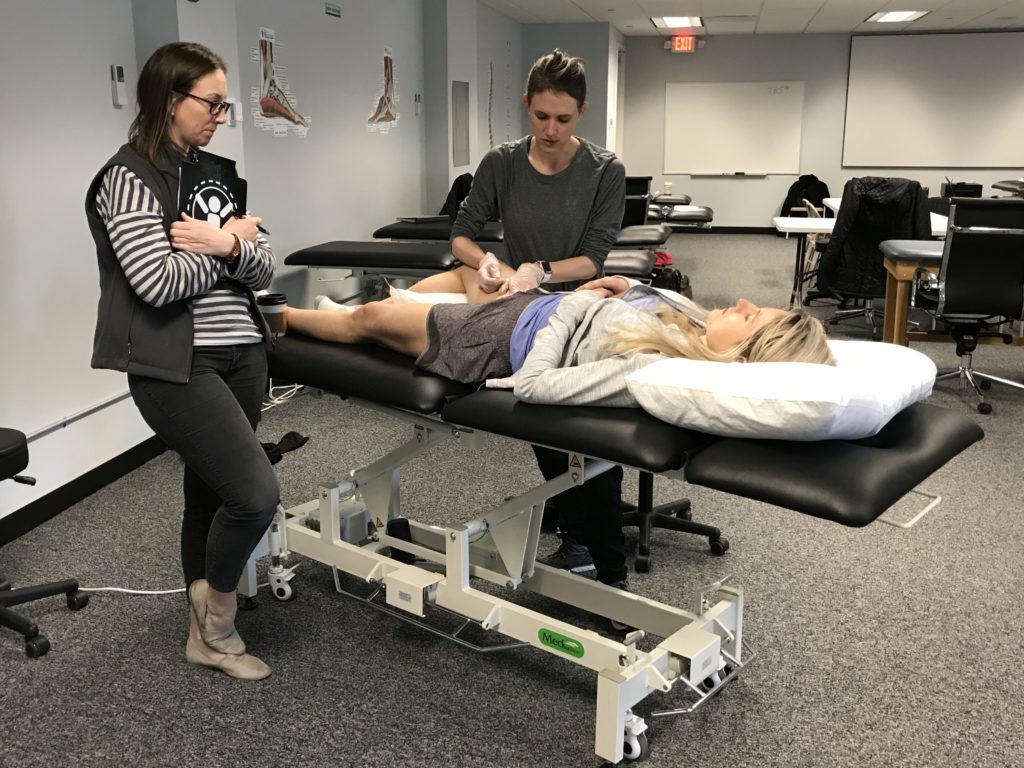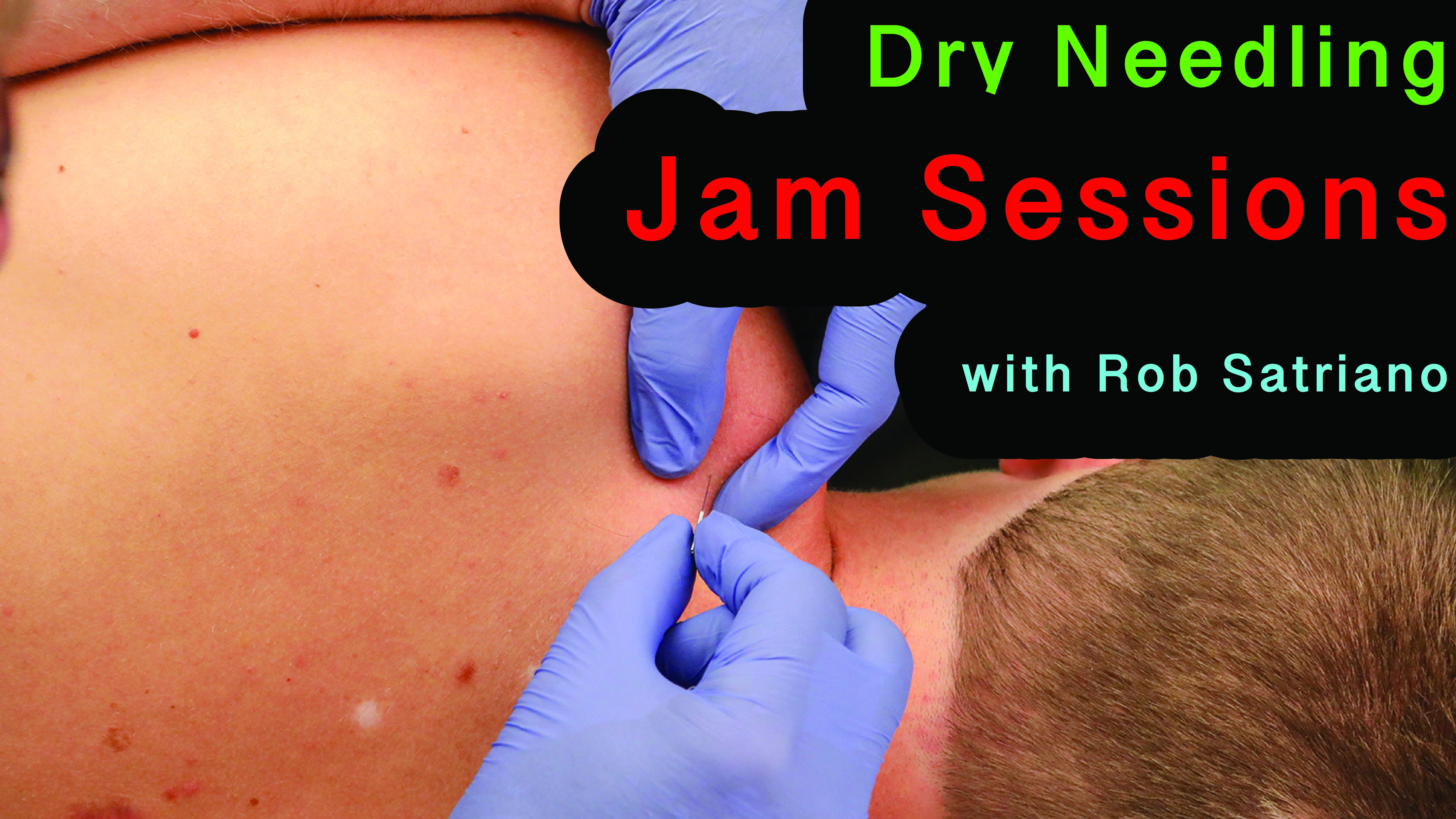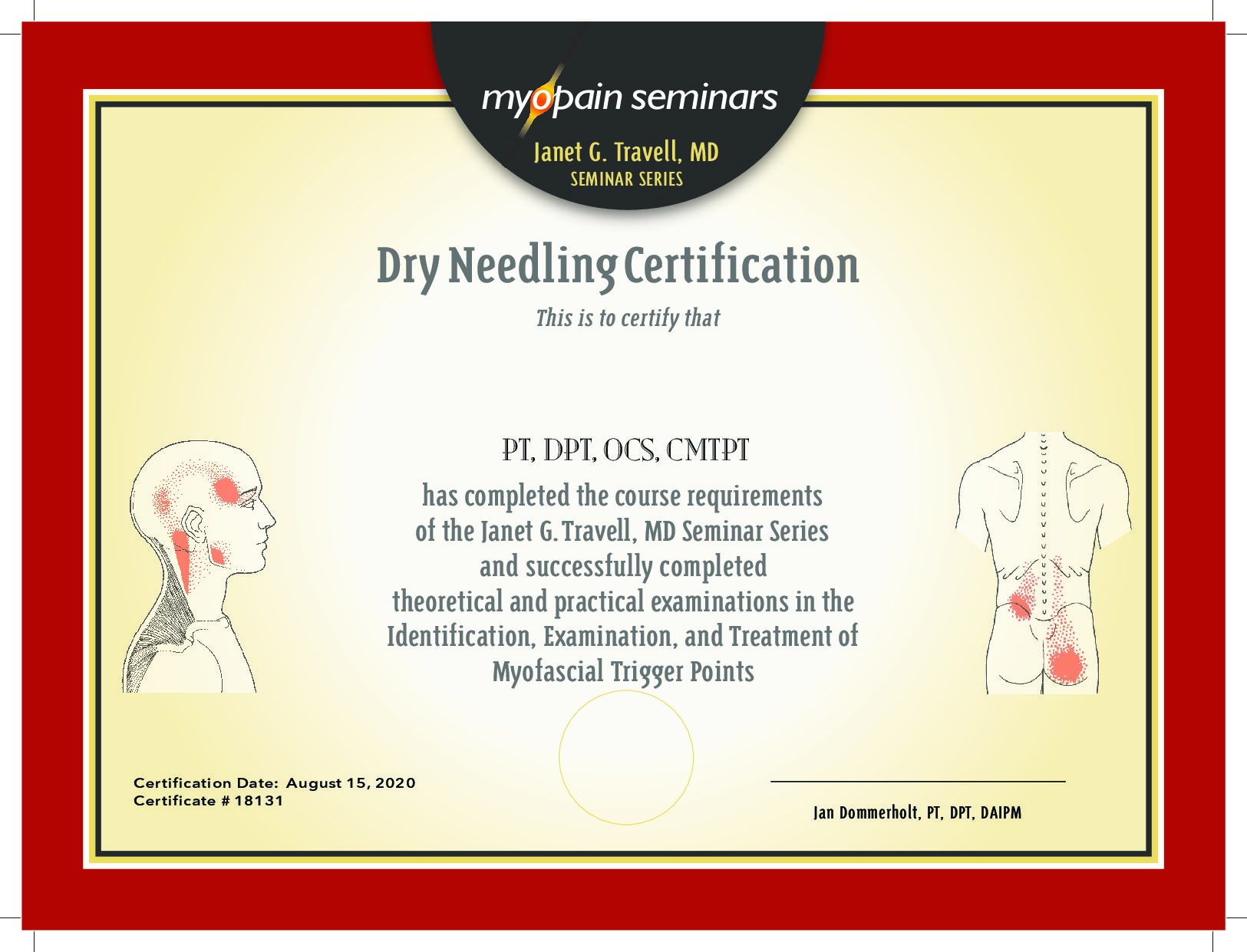The Myopain Seminars Dry Needling course program consists of three courses followed by theoretical and practical examinations. Upon completion of the course program, you will not only be recognized as a Certified Myofascial Trigger Point Therapist / Dry Needling (CMTPT/DN), you will also have achieved the highest level of dry needling and be familiar with the current scientific literature.
Generally speaking, there are intrinsic and extrinsic benefits of getting certified. An extrinsic benefit is that completing the program will set you apart from other clinicians. Your patients will recognize and appreciate your professional achievements. Why go to a physical therapist who did not take the extra step to become certified? Another extrinsic benefit of getting certified may include career advancement. If you ever plan to change jobs, certifications make a resume stand out.
Professional and personal growth are more intrinsic values. Going through the challenging process of getting certified is very rewarding. Some students may value other priorities more, which often are related to life circumstances, such as participating in community events, recreational activities, attending to children, playing sports, etc.

Interestingly, in a study of perioperative nurses, Gaberson et al. found that over 90% of the participants considered getting certified as a personal accomplishment and a challenge that validated their specialized knowledge, professional growth, attainment of a practice standard, professional commitment, and credibility. A recent study of the attributes of expert physiotherapy continence clinicians demonstrated that therapists with post-graduate qualifications “frequently mentor novice clinicians, foster consumer-focused and high-quality healthcare, contribute to research generation and implementation and measure therapy outcomes using valid tools” (Slade et al, 2020). Indeed, advanced practice physiotherapists commonly hold qualifications and certifications beyond entry-level skills (Fennelly et al, 2020).
Yet, some PTs attend only the minimally number of courses required by their state physical therapy board and they do not seem interested in attending any more courses. Since several state boards require around 50 hours of education, these PTs may attend only two dry needling courses. While these PTs may have enough basic skills to treat most of their patients, at times they will not be prepared and qualified when muscles are involved that they did not study. In the Myopain Seminars dry needling courses, most of the calf muscles are covered in the third course, and these muscles are frequently involved in pain commonly attributed to plantar fasciitis, Achilles tendinopathy, or even heel spurs (Eftekharsadat et al., 2016; Uygur et al., 2019).
 An even greater concern is how these therapists will explain why they did not complete the certification when they get challenged in court. While serious adverse events with dry needling are rare (Brady et al., 2014; Mabry et al., 2020; Boyce et al., 2020), accidents do happen. Imagine the scenario where a PT, who did not bother to get certified in dry needling, is being challenged in court:
An even greater concern is how these therapists will explain why they did not complete the certification when they get challenged in court. While serious adverse events with dry needling are rare (Brady et al., 2014; Mabry et al., 2020; Boyce et al., 2020), accidents do happen. Imagine the scenario where a PT, who did not bother to get certified in dry needling, is being challenged in court:
Plaintiff Attorney (PA): “Do you always provide the best possible care to your patients?”
PT: “Of course! I am proud of being a physical therapist and always look after my patients.”
PA: “Are there any areas of specialization in physical therapy?”
PT: “Yes, one can become board certified, for example in orthopedic or sports PT.”
PA: “Are there other certification programs, for example following post-graduate continuing education programs?”
PT: “Yes, there are several such programs.”
PA: “Can you name a few such certification programs?”
PT: “Well, a PT can become certified in McKenzie, in manual therapy, or in manual lymph drainage, just to name a few.”
PA: “What is the value of getting certified in let’s say, manual therapy?”
PT: “Getting certified shows that you value going the extra mile and that you really master a particular technique or approach.”
PA: “Do you believe that getting certified in one of the specialties you mentioned is worth it?”
PT: “I guess so….”
PA: “Are there certifications in dry needling?”
PT: “Yes, there are several dry needling certifications.”
PA: “You have been trained in dry needling?”
PT: “Yes, I have.”
PA: “And you feel that you are qualified to use dry needling in your practice?”
PT: “Yes, I do.”
PA: “Looking at your resume, I do not see that you are certified in dry needling. Did you forget to mention it on your CV?”
PT: “ Well, I attended several dry needling courses.”
PA: “Did the company where you studied dry needling offer a certification?”
PT: “Yes they do.”
PA: “Did you not tell the court that you provide the best possible care to your patients? But you did not make the effort to get certified in dry needling? In other words, if I may quote you, apparently you were not that interested in providing the best possible care since you did not go the extra mile and demonstrate that you really master dry needling? Could that be the reason that we are here today because you caused an injury to my client that you possibly could have prevented by becoming certified?”
PT: “Uh…….
Certification shows that you value being tested against high standards, confirming your knowledge and practical skills in dry needling. To your patients, you show that you are committed to lifelong learning and dedicated to providing the best possible patient care.
References
Boyce, D, Wempe, H, Campbell, C, Fuehne, S, Zylstra, E, Smith, G, Wingard, C & Jones, R, 2020. Adverse events associated with therapeutic dry needling. Int J Sports Phys Ther, 15, 103-113.
Brady, S, McEvoy, J, Dommerholt, J & Doody, C, 2014. Adverse events following dry needling: A prospective survey of Chartered Physiotherapists. J Manual Manipul Ther, 22, 134-140.
Eftekharsadat, B, Babaei-Ghazani, A & Zeinolabedinzadeh, V, 2016. Dry needling in patients with chronic heel pain due to plantar fasciitis: A single-blinded randomized clinical trial. Med J Islam Repub Iran, 30, 401.
Gaberson KB, Schroeter K, Killen AR, Valentine WA. 2003. The perceived value of certification by certified perioperative nurses. Nurs Outlook., 51:272-276.
Fennelly, O, Desmeules, F, O’Sullivan, C, Heneghan, NR & Cunningham, C, 2020. Advanced musculoskeletal physiotherapy practice: Informing education curricula. Musculoskelet Sci Pract, 48, 102174.
Mabry, LM, Notestine, JP, Moore, JH, Bleakley, CM & Taylor, JB, 2020. Safety events and privilege utilization rates in advanced practice physical therapy compared to traditional primary care: an observational study. Military Medicine, 185, e290-e297.
Slade, SC, Hay-Smith, J, Mastwyk, S, Morris, ME & Frawley, H, 2020. Attributes of physiotherapy continence clinicians: a qualitative perspective. Physiotherapy, 106, 119-127.
Uygur, E, Aktas, B, Eceviz, E, Yilmazoglu, EG & Poyanli, O, 2019. Preliminary Report on the Role of Dry Needling Versus Corticosteroid Injection, an Effective Treatment Method for Plantar Fasciitis: A Randomized Controlled Trial. Journal of Foot and Ankle Surgery, 58, 301-305.


